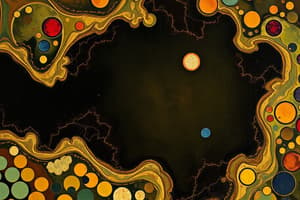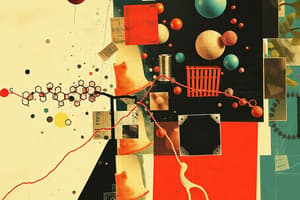Podcast
Questions and Answers
What are enzymes?
What are enzymes?
Organic compounds (Proteins) produced by living cells to speed up and regulate the rate of reactions.
Which enzyme is used in medical treatment to dissolve blood clots?
Which enzyme is used in medical treatment to dissolve blood clots?
Streptokinase
Which enzyme is used for juice clarification?
Which enzyme is used for juice clarification?
- Pectinase (correct)
- Rennin
- Zymase
- Streptokinase
What is activation energy?
What is activation energy?
What suffix is added to the root word to name enzymes?
What suffix is added to the root word to name enzymes?
Name one factor that influences enzymatic activity.
Name one factor that influences enzymatic activity.
Certain enzymes produced in inactive form are known as ______.
Certain enzymes produced in inactive form are known as ______.
Which class of enzyme helps in the transfer of functional groups?
Which class of enzyme helps in the transfer of functional groups?
What do you call the enzyme system that is a combination of a cofactor or coenzyme with an apoenzyme?
What do you call the enzyme system that is a combination of a cofactor or coenzyme with an apoenzyme?
What happens to the reaction rate with an increase in enzyme concentration?
What happens to the reaction rate with an increase in enzyme concentration?
Match the following enzymes with their actions:
Match the following enzymes with their actions:
Study Notes
Enzymes
- Organic compounds, primarily proteins
- Produced by living cells
- Speed up and regulate the rate of chemical reactions inside and outside cells
- Enable life processes to occur at normal temperatures.
Uses of Enzymes
- Medical Treatment:
- Streptokinase dissolves blood clots.
- Genetic Engineering:
- Restriction endonucleases cut DNA at specific sites.
- Ligases join DNA fragments.
- Cleaning of Hides:
- Proteases break down proteins in meat and viscera.
- Clearing of Juices:
- Pectinase clarifies juice by breaking down pectin.
- Alcoholic Drinks:
- Zymase is used in the fermentation process to produce alcohol.
- Cheese Formation:
- Rennin, an enzyme from the calf's stomach, is used for cheese production.
How Enzymes Work
- Activation Energy: The minimum energy required to initiate a reaction.
- Enzymes lower activation energy, speeding up the reaction and facilitating product formation.
Enzyme Nomenclature
- Suffix "-ase": Lipase, protease, etc.
- Type of Reaction Catalyzed: Dehydrogenase removes hydrogen.
- Two-Part System: First part indicates the substrate, and the second identifies the catalyzed reaction (e.g., DNA polymerase: synthesis of DNA).
- Source: Papain is derived from papaya.
- "IN" Prefix: Pepsin and trypsin were classified before modern nomenclature.
Examples of Enzyme Activity
- The oxidation of fatty acids (e.g., in metabolism) occurs smoothly and rapidly within the body, despite requiring extreme conditions in a laboratory setting.
- In the laboratory, protein breakdown requires boiling for 24 hours in a strong acid solution, yet it occurs quickly in the body under mild conditions.
Enzyme Mechanism
- Lock and Key Model: The enzyme's active site has a specific shape that fits the substrate.
- Induced Fit Model: The enzyme's active site changes shape to fit the substrate, facilitating bonding.
Enzyme Classification
- Oxido-reductases: Catalyze oxidation-reduction reactions, transferring electrons or protons (H+). Example: Dehydrogenases
- Isomerases: Catalyze the conversion of one isomer to another. Example: Glucoisomerases.
- Hydrolases: Break down molecules by adding water (hydrolysis). Examples: Esterases, carbohydrases.
- Lyases: Break bonds by means other than hydrolysis or oxidation. Example: Histidine decarboxylase.
- Ligases (Synthetases): Join two molecules together, using energy from ATP. Example: Pyruvate carboxylase.
- Transferases: Transfer a functional group from one molecule to another. Example: Hexokinase transfers a phosphate group from ATP to glucose.
Prosthetic Groups
- Non-protein components associated with enzymes.
- Can be inorganic or organic.
Cofactors
- Simple metal ions that act as prosthetic groups. Examples: Fe2+, Cu2+, Mg2+.
Coenzymes
- Organic prosthetic groups.
Apoenzyme
- The protein part of an enzyme that requires a cofactor or coenzyme to function.
Holoenzyme
- The complete functional enzyme complex, consisting of the apoenzyme and cofactor/coenzyme.
Isoenzymes
- Enzymes with slightly different molecular structures but similar catalytic functions. Example: Lactic dehydrogenase.
Turnover Number
- The number of substrate molecules acted upon by one enzyme molecule per unit time.
Intracellular Enzymes (Endozymes)
- Remain and function within cells. Example: Respiratory enzymes.
Extracellular Enzymes (Exozymes)
- Leave the cell and function outside. Example: Salivary amylase.
Zymogens (Proenzymes)
- Inactive forms of enzymes that are activated under specific conditions.
Factors Affecting Enzyme Activity
- Enzyme Concentration: Increased concentration leads to a faster reaction rate.
- Substrate Concentration: Increased concentration increases reaction rate up to a point where enzyme saturation occurs, limiting the rate.
- Product Concentration: Accumulation of product can inhibit enzyme activity.
- Temperature: Increased temperature generally increases reaction rate, but excessive heat can denature the enzyme.
- pH: Each enzyme has an optimal pH range for activity.
Studying That Suits You
Use AI to generate personalized quizzes and flashcards to suit your learning preferences.
Related Documents
Description
This quiz explores the role of enzymes as organic compounds primarily made of proteins. Learn how they function in various processes, from medical treatments to genetic engineering, and understand their significance in everyday applications like food production and cleaning. Test your knowledge on the mechanisms of enzyme action and their importance in biological processes.




